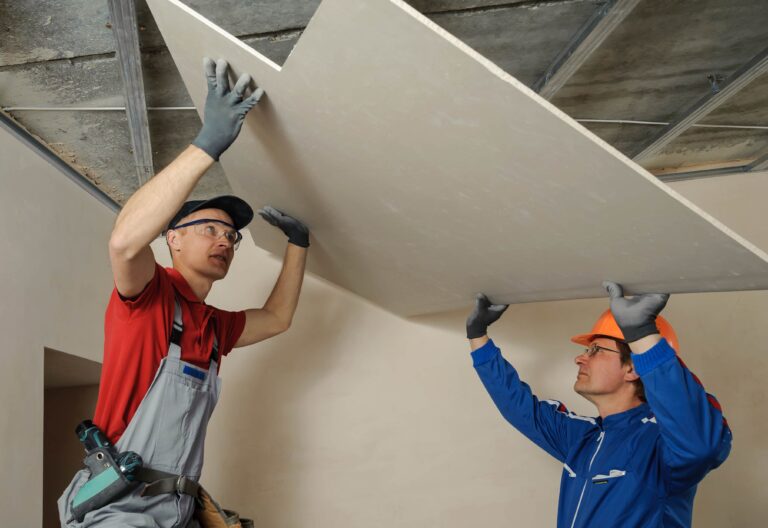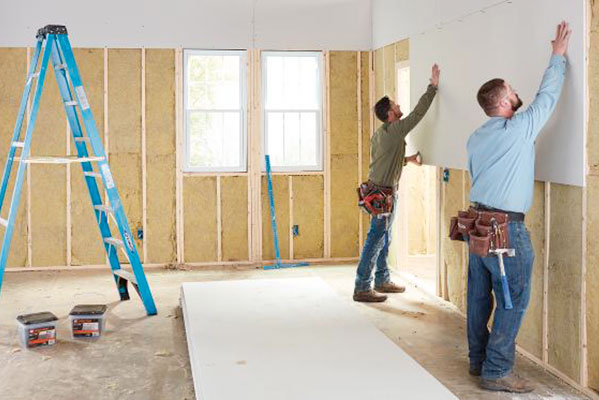Efficient Drywall Repair Techniques to Recover Your Walls
Efficient Drywall Repair Techniques to Recover Your Walls
Blog Article
Drywall Setup Made Easy: Tips for Perfect Results
Drywall installment is usually perceived as a complicated job, yet with the best method and expertise, it can become a workable undertaking. Mastering techniques for reducing, hanging, and ending up drywall can considerably influence the result.
Picking the Right Products
Choosing the ideal materials for drywall setup is important to attaining a long lasting and aesthetically pleasing finish. drywall installation. The primary component, drywall sheets, typically can be found in various thicknesses, with 1/2-inch sheets being conventional for interior walls. For areas needing extra moisture resistance, such as cooking areas or shower rooms, consider using green board or concrete board, which are particularly designed to endure moisture

In addition, picking the best fasteners-- either nails or screws-- is necessary for safeguarding the drywall to the framing. Drywall screws are normally preferred for their holding power and decreased danger of standing out. Consider the finishing touches such as primer and paint, which not only boost the look yet additionally safeguard the drywall from wetness and wear.
Preparing the Setup Location
Prior to beginning the drywall installment process, it is vital to prepare the setup location thoroughly. This preparation entails several crucial actions to make certain a smooth and successful project. Clear the location of any furniture, home appliances, or blockages that can impede access. A tidy work space decreases the risk of damage to existing products and enables effective movement throughout installment.
Next, inspect the walls and ceiling for any imperfections, such as fractures, holes, or mold. Address these concerns in advance; spot any damages and allow adequate time for repair work to completely dry. Additionally, make sure that electric outlets, switches, and pipes are effectively placed and represented, as this will impact drywall placement.
Consider the ecological problems. A stable temperature and humidity level are crucial for optimal adhesion and performance of the drywall materials. If required, use a dehumidifier or heating system to create ideal problems.
Trimming and Hanging Drywall
The secret to efficient drywall installment depends on the exact cutting and hanging of the panels. Begin by gauging the space precisely, thinking about any type of blockages such as electric outlets or windows. Make use of a straight edge and an utility knife to rack up the drywall along your dimensions, after that break it along Get More Info the scored line for a clean break. For more detailed cuts, such as around electrical outlets, a drywall saw can be made use of for precision.

Always work from the top down and left to right, making certain that you keep a staggered pattern to boost stability. Appropriately hanging the drywall sets the structure for a smooth surface, eventually leading to remarkable outcomes in your drywall project.
Taping and Mudding Methods
While proper cutting and hanging of drywall sets the phase, the following critical action entails understanding taping and mudding techniques to make sure a smooth finish. Insulation is essential for reinforcing joints and avoiding fractures; it entails installing tape right into the applied joint compound (mud) Begin with a top quality fiberglass or paper tape, using the tape over the joint and pushing it right into the damp mud making use of a taping knife, guaranteeing no air bubbles remain.
When the tape remains in place, use a slim layer of joint substance over the tape, feathering the edges to create a smooth change to the drywall surface. Enable this layer to dry totally prior to sanding it lightly to eliminate imperfections. Repeat this process, using additional layers of mud as needed-- commonly 2 to 3 coats-- while progressively broadening the application area with each layer to attain a seamless appearance.
After go to the website the last layer dries out, sand the surface area with a fine-grit sandpaper up until smooth. sheetrock repair fort worth. Remember to wear a mask during fining sand to avoid inhaling dirt fragments. Understanding these taping and mudding methods is critical for achieving a professional-quality finish in your drywall setup
Ending Up Touches for Perfection
Accomplishing a flawless drywall installment goes beyond mudding and taping; read what he said it finishes in the ending up touches that elevate the total appearance. These final actions are vital in guaranteeing a professional-grade finish that improves the looks of your space.
Begin by sanding the dried out joint substance to develop a smooth surface. drywall contractor. After sanding, clean down the walls with a wet fabric to eliminate any kind of dust bits, making certain a clean surface area for painting.
Following, use a primer especially made for drywall. This action is crucial, as it aids seal the joint compound and provides an uniform base for the overcoat. As soon as the guide dries, evaluate for any blemishes, and retouch as required.
Conclusion
Finally, effective drywall installment hinges on the careful choice of products, extensive prep work of the installment area, and specific implementation of cutting and hanging techniques. Proficiency of taping and mudding processes is crucial for attaining a smooth coating. Additionally, attention to finishing touches, including priming and touch-ups, ensures a professional-grade result. By sticking to these guidelines, the high quality of craftsmanship can be substantially enhanced, adding to the general aesthetic and functionality of the room.
Drywall installation is frequently perceived as a challenging job, yet with the ideal strategy and expertise, it can come to be a manageable venture.Selecting the ideal materials for drywall setup is crucial to attaining a long lasting and visually pleasing coating.Prior to beginning the drywall installation process, it is essential to prepare the installment area completely. Grasping these taping and mudding techniques is vital for achieving a professional-quality surface in your drywall installation.
In conclusion, successful drywall installation hinges on the careful choice of materials, comprehensive preparation of the installment location, and precise execution of reducing and hanging methods.
Report this page